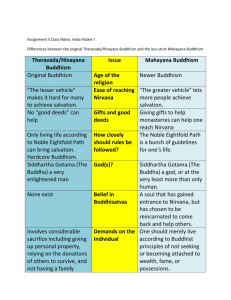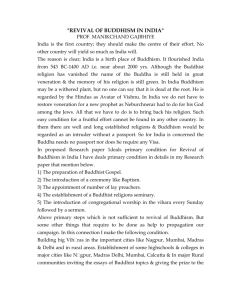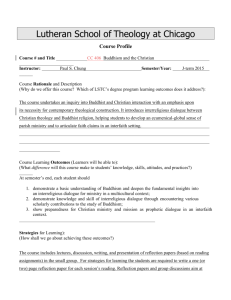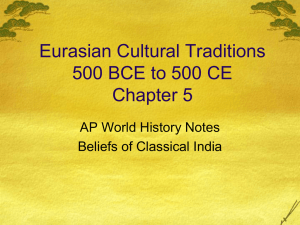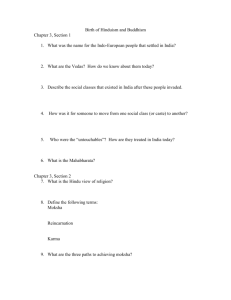Almost 2600 years ago Siddhartha Gautama was born in a garden
advertisement
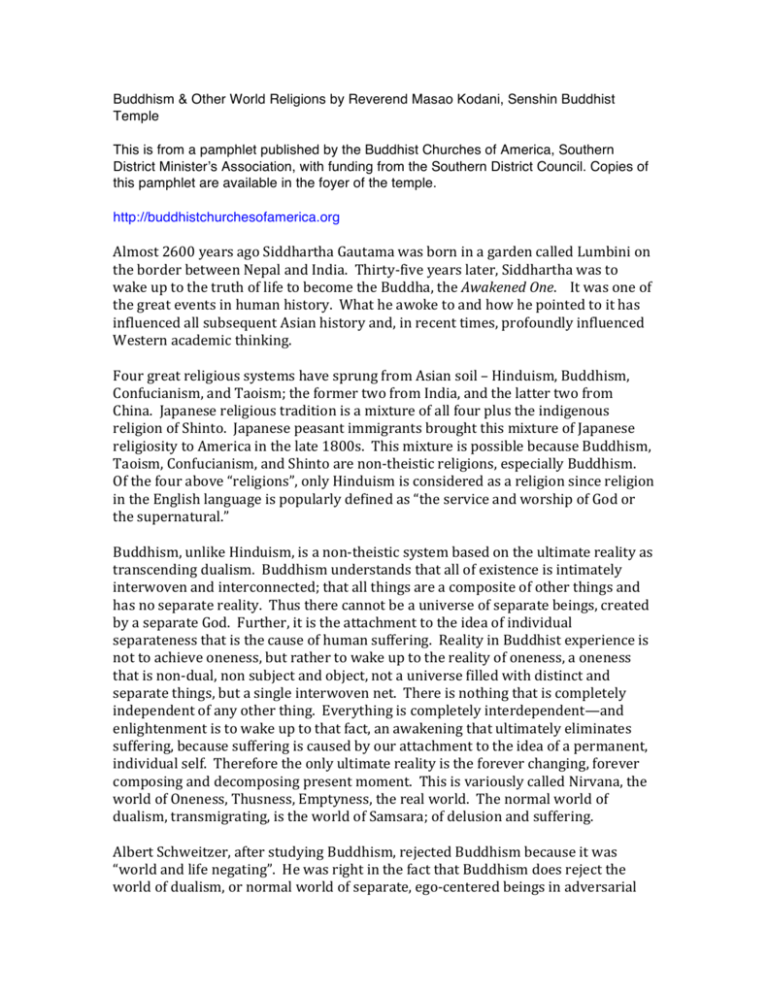
Buddhism & Other World Religions by Reverend Masao Kodani, Senshin Buddhist Temple This is from a pamphlet published by the Buddhist Churches of America, Southern District Minister’s Association, with funding from the Southern District Council. Copies of this pamphlet are available in the foyer of the temple. http://buddhistchurchesofamerica.org Almost 2600 years ago Siddhartha Gautama was born in a garden called Lumbini on the border between Nepal and India. Thirty-­‐five years later, Siddhartha was to wake up to the truth of life to become the Buddha, the Awakened One. It was one of the great events in human history. What he awoke to and how he pointed to it has influenced all subsequent Asian history and, in recent times, profoundly influenced Western academic thinking. Four great religious systems have sprung from Asian soil – Hinduism, Buddhism, Confucianism, and Taoism; the former two from India, and the latter two from China. Japanese religious tradition is a mixture of all four plus the indigenous religion of Shinto. Japanese peasant immigrants brought this mixture of Japanese religiosity to America in the late 1800s. This mixture is possible because Buddhism, Taoism, Confucianism, and Shinto are non-­‐theistic religions, especially Buddhism. Of the four above “religions”, only Hinduism is considered as a religion since religion in the English language is popularly defined as “the service and worship of God or the supernatural.” Buddhism, unlike Hinduism, is a non-­‐theistic system based on the ultimate reality as transcending dualism. Buddhism understands that all of existence is intimately interwoven and interconnected; that all things are a composite of other things and has no separate reality. Thus there cannot be a universe of separate beings, created by a separate God. Further, it is the attachment to the idea of individual separateness that is the cause of human suffering. Reality in Buddhist experience is not to achieve oneness, but rather to wake up to the reality of oneness, a oneness that is non-­‐dual, non subject and object, not a universe filled with distinct and separate things, but a single interwoven net. There is nothing that is completely independent of any other thing. Everything is completely interdependent—and enlightenment is to wake up to that fact, an awakening that ultimately eliminates suffering, because suffering is caused by our attachment to the idea of a permanent, individual self. Therefore the only ultimate reality is the forever changing, forever composing and decomposing present moment. This is variously called Nirvana, the world of Oneness, Thusness, Emptyness, the real world. The normal world of dualism, transmigrating, is the world of Samsara; of delusion and suffering. Albert Schweitzer, after studying Buddhism, rejected Buddhism because it was “world and life negating”. He was right in the fact that Buddhism does reject the world of dualism, or normal world of separate, ego-­‐centered beings in adversarial stances in eternal conflict. It points to the natural world of non-­‐duality as the real world, the world of Nirvana, of the Pure Land. And those are not separate worlds, one in the present and one in the future. Samsara is the normal world seen through the glasses of the ego-­‐self, where “I” and “I” and “you” and “you” and never the twain shall meet. Nirvana is that same world seen without the “I”-­‐centered eyeglasses, and that real and natural world can only be in the ever-­‐changing present moment. Buddhists therefore are not a community of believers, but rather a community of people trying to become aware of our inter-­‐connectedness. Hence the ideas of individuality and freedom are significantly at odds with Western and particularly American views on the subject. In America, people are generally viewed as separately created beings, either by a creator God or through the natural processes of science. Each distinct being therefore must struggle to find his place among other distinct beings and define his individuality—to do so is to be free. The individual therefore, must be nurtured, protected, taught how to protect himself, and meet the challenges of everyday living. The stance is an adversarial one, the stance of warriors. We are exhorted to fight the good fight, to grab all the gusto you can, to be the best in all things, to win at all costs, etc., etc. It is a warrior culture of conquerors and samurai, affirming the glory of battle and conquest, all the while affirming the idea of a “war to end all wars”. Along comes Buddhism that says the idea of a distinct individual, separate from all other individuals, is a mistaken one. What the individual is, at any given moment, is the sum total of all the connections and influences he has encountered in his lifetime. He is not a being, but a be-­‐ing, a be-­‐ing that is constantly changing. Our normal state of self-­‐delusion sees the universe made up of distinct and separate things relating to each other. Buddhism sees he universe as a net of relationships with each intersection of the net as seemingly real but only for purposes of maintaining our self-­‐deception. Real life then, is not a struggle, not a challenge, not a problem to b solved, but rather an interconnected wonder to behold and enjoy. One finds meaning in life by connecting to it, or more accurately, seeing that one is connected. Buddhist Oneness is a fact, not an accomplishment. Relating is real, the thing relating is only provisionally real. Cooperation is a natural outcome of experiencing Oneness. It is no accident that Jodo Shinshu flourished among the peasant class of Japan. In Jodo Shinshu, this self-­‐deception is called Namo. Amidabutsu is the net itself. And Namoamidabutsu is the statement that this pair of opposites, at the same time, constitutes a single reality. The Haiku poet and Nembutsu follower, Kobayashi Issa expresses it in more direct terms: The dewdrop world…………………………………………………………Tsuyu no yō wa Is truly the dewdrop world ……………………………………………...Tsuyu no yō nagara And yet, and yet ………………………………………………………………Sarinagara The world is like a dewdrop, appearing and disappearing in an instant—and this is the reality of the world. And yet, and yet, how I long for and cling to the delusory world of separate individuals, of me, of this and that. We now that clinging is the great blinder; and yet we cling, and still we cling to this illusion. At the same time we know the real world of the Pure Land and Amida. Issa says: Simply trust:……………………………………………………………………Tada tanome Do not the petals flutter down………………………………………….Hana mo hara hara Just like that? ………………………………………………………………….Ano tori Jodoshinshu is not about believing in a supreme being called Amida Buddha and praying Namoamidabutsu and reincarnating in a place called the Pure Land. It is mainstream Buddhism of a kind faithful to the vision of Siddhartha Gautama Shakyamuni. And all this with Confucian ethics—enryō (civility), oyakōokō (filial respect), ancestor reverence, the value of age over youth, the ideas of good governance, a bureaucracy based on tested merit; and Taoist views of mottainai (the unnaturalness of waste), the folly of brute strength, confrontation and manipulation, etc.

